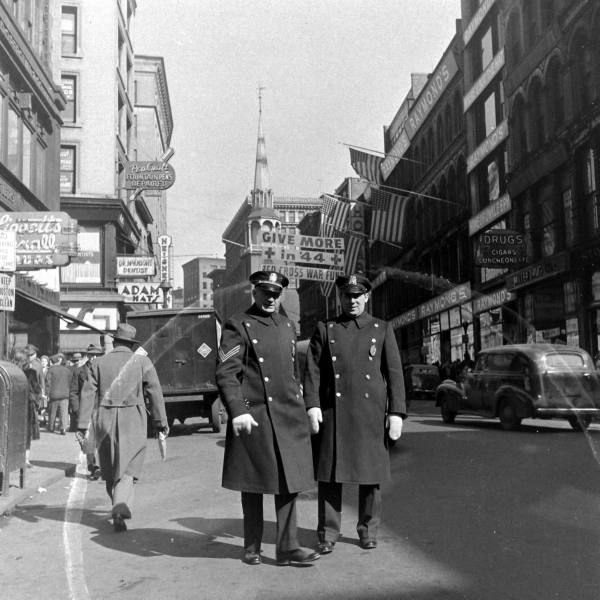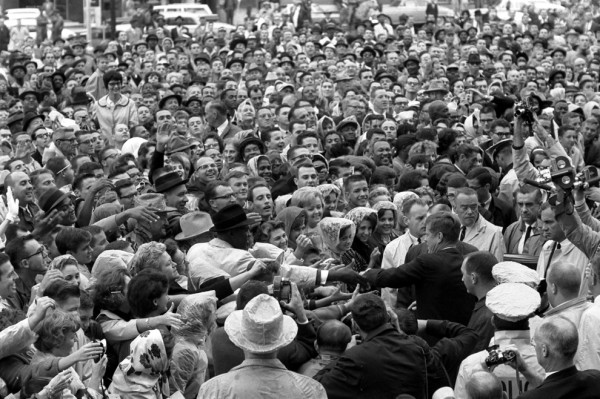In this TED video, Denis Dutton explains how our shared sense of what is beautiful may have its origin in human evolution. The theory connects to another idea I ran across recently: that we humans acquired our species-wide instinct for storytelling as a biological adaptation. Telling one another stories conferred on our ancient ancestors an advantage, i.e. storytelling animals were more likely to survive than non-storytelling ones. Brian Boyd seems to be the leading exponent of this theory with his book, On the Origin of Stories. (Boyd summarizes the theory here. An interesting review of the book by Michael Bérubé is here.) If all this is true — if we are hardwired to find certain art forms beautiful and to enjoy certain kinds of stories — then maybe we should not worry so much about the death of the novel after all.
Blog
Garrison Keillor: Advice to writers
11.22.63
November 22nd, 1963: President Kennedy reaches out to the crowd gathered at the Hotel Texas Parking Lot Rally in Fort Worth, Texas. (Cecil Stoughton, White House / John F. Kennedy Library) (via)
Quote of the Day
A great many people think they are thinking when they are merely rearranging their prejudices.
William James
Boston, February 1944

Photo by Walter Sanders for Life Magazine.
Shoes
This video made the rounds on the web a while ago, when Converse announced the latest reinterpretation of its sneakers by designer Ryusaku Hiruma, but I only discovered it the other day.
Fashion clod that I am, I had never heard of Hiruma or his Converse shoes. For the uninitiated: Ryusaku “Sak” Hiruma is a Japanese designer who has been studying traditional shoemaking techniques in Florence for almost a decade. Over the last few years, Sak has applied old-world craft to produce chic, luxurious handmade versions of Converse’s classic Jack Purcell, Chuck Taylor, and One Star models. The latest Sak/Converse shoe, a design based on an old basketball shoe called the Star Tech, features fine leather and hand-stitching throughout. Only 64 pairs will be made, in natural shades of tan, off-white and black leather. Retailing for $600, they will be available only in New York, Boston, and Costa Mesa. (Costa Mesa?) If you’re into shoe porn, details are here and here.
I loved this video. I found it oddly touching and romantic, not just for Sak’s dedication to craft and tradition but for personal reasons. My own family was in the shoe business for several generations. Growing up, I assumed I would be too. There were no writers or artists of any kind in my family or anywhere else in my world. Even now I think I might have been very happy making shoes.
Maybe that is why I have a nagging sense that, as a writer, I don’t really “make” anything. A book is an ethereal creation, a non-object. It exists as a chain of words, separate and apart from the paper-and-ink thing we call by that name. Book publishing is only now transitioning to digital, permanently alienating the idea of a “book” from a physical object, but writing made the leap decades ago. In my own daily working life, paper plays no part. Over the two years or so it takes me to produce a novel, I never print out a hard-copy manuscript. And when I am done, I simply email a digital file to my editor. There is no object to hold, really, until I receive bound copies from the publisher, long after the writing is done. Even then, the physical books do not feel like my creation. Only the words do.
Contrast that with the intensely physical world of traditional shoemaking in this video. The materials are so lush and sensuous. Even the tools have a gorgeous patina. That the shoemaker’s artistry is lavished on such a low, practical object — when you step in shit, it is not your hat that is ruined — only makes the concrete physicality of the whole thing that much more real and authentic. Only 64 pairs of these shoes will be made, and Hiruma will touch every one with his own hands. And, poignantly, every one one of those shoes will wear out.
Novels, of course, are theoretically immortal precisely because they are insubstantial. My books can be reprinted and rescreened into infinity, and each copy is no less my creation than any other. Maybe that is what makes the shoemaker’s art so poignant to a writer: he cannot give you his creation without surrendering it himself.
Kanye West: Power
Eddie Coyle comes to the stage, almost
Saturday afternoon, a new stage play of “The Friends of Eddie Coyle” was unveiled at the Burren in Somerville. The little theater at the back of the bar was packed. I’d guess there were 150 or so people there. There was a wonderful excited mood in the room. This was a one-off performance of a work in progress, a peek into the process of how a play is shaped. It was only a staged reading — actors reading from scripts, no costumes or sets — so it is obviously too early to comment on the production itself, but so far it looked very promising.
The difficulties and pleasures of staging “Eddie Coyle” are about what you’d expect. Higgins’ wised-up streetcorner dialogue begs to be spoken aloud, and a lot of the novel’s best riffs are recited seemingly verbatim. The hard part is compressing the story onto a small stage, especially on a limited budget. The novel includes scenes in cars, a bank robbery, a home invasion, a trashy trailer home, a supermarket parking lot, a Bruins game at Boston Garden. Worse, in the book the plot itself is shadowy. Higgins does not spell out what is happening to Eddie. He lets the dialogue swirl around and around, and it is up to the reader to piece the story together, just as it is up to Eddie. On a first reading, the book can be confusing. Obviously that won’t work on stage. So playwright Bill Doncaster has altered a few scenes and dropped others to streamline and clarify. The results were mostly good. Some incidents (the arrest of Jackie Brown, the invasion of a banker’s home in Lynn) were hard to follow if you didn’t know the story beforehand. But, again, this was only a walk-through on a bare stage. The play is a work in progress. When it is properly staged and after some tinkering with the script, these things will become clearer.
More important than all these technical things, the play is true to the spirit of Higgins’ novel, truer even than the 1973 movie starring Robert Mitchum (which I love). Mitchum gave a great performance as Eddie Coyle, but to me he was miscast. Mitchum was a leading man, big, charismatic, cool. Eddie Coyle is none of these things. He is a loser at the bottom rung of semi-organized crime, past his prime, used by everyone around him from the guy who hires him to drive a truckload of stolen booze to the FBI agent who squeezes him for tips. It would have been a good role for a “Midnight Cowboy”-era Dustin Hoffman rather than Mitchum. Eddie is Ratso Rizzo with a Boston accent and a few extra pounds. Doncaster’s play gets this bottom-feeding world just right.
The three lead actors are wonderful. Eddie is played here by Paulo Branco, a local actor who reminded me of the film actor Dan Hedaya. Branco plays Eddie as an anti-Mitchum: desperate, whiny, weak, dense, a loser just smart enough to know how much danger he is in. Great casting, great choices by the actor. To watch Branco cheer like an exuberant little kid for Bobby Orr gives you a completely different Eddie Coyle than Mitchum’s cool, heavy-lidded portrayal. (And if you have to ask why those 1969-70 Bruins would make a grown man cheer like a kid, you are either too young to remember or you aren’t from Boston. I know where I was on Mothers Day in 1970.)
Rick Park as Dillon is the other cornerstone of this production. I chatted with Bill Doncaster yesterday, and he mentioned that he saw Dillon as a sort of Iago, a perspective that really sharpens this character. Dillon is even more important here than in the book or movie. Rick Park brings some of the heaviness and watchful intelligence that Peter Boyle brought to the role in the film. His Dillon is older, wiser, wearier than Boyle’s, a sharper character even than Higgins drew in the book.
The other standout in the cast is Peter Darrigo, who makes a completely convincing Boston tough guy in the role of Coyle’s associate Jimmy Scalisi. On the down side, Tom Berry seems to be searching still for how to play the FBI agent Dave Foley. Foley comes off here as just another wiseguy rather than a button-down Fed who works in an office, not on a streetcorner. In the story, Foley uses Eddie and betrays him without a second thought. That requires a more complex character than Berry has managed to capture so far. But this is a work in progress — it is too early to criticize a performance. It is hard to hold back, though. I am rooting for this production, so I want Berry to succeed.
So far the play looks great. Doncaster tells me he is still searching for a theater to stage it. Here’s hoping he finds one. It is hard to believe that after all these years there could be a fresh take on The Friends of Eddie Coyle, but this could be one. If you’re a Bostonian, you should be rooting for this play to make it.
More info from the Boston Globe here. You can also join a Facebook page for the production here.
